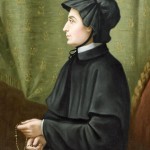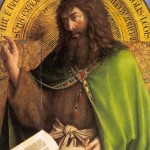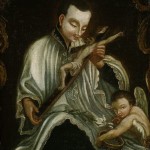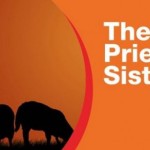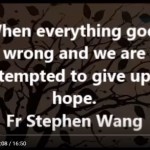Loneliness, part 4: the experience of Christ
An acceptance of the “original solitude” of Eden is called, in time, to mature into the loneliness as experienced by Christ in Gethsemane. In Jesus of Nazareth, Pope Benedict XVI writes of this defining event:
…it was here (Gethsemane) that Jesus experienced that final loneliness, the whole anguish of the human condition. Here the abyss of sin and evil penetrated deep within his soul. Here he was to quake with foreboding of his imminent death. Here he was kissed by the betrayer. Here he was abandoned by all the disciples. Here he wrestled with his destiny for my sake.
In Gethsemane, Jesus is assaulted by two expressions of loneliness: the loneliness of being abandoned by his disciples at the moment when he most needed their concern and, as the only one who could accomplish our redemption, the loneliness of freely accepting the terrible weight of all that is cruel, degrading and godless in human history.
Gethsemane represents the climax of the loneliness that Christ experienced in his human nature. “The consciousness which Jesus had of himself,” writes Edward Malatesta in his essay, “Jesus and Loneliness”, ”of his unique identity, of his unique relationship to the Father and the Holy Spirit, to the universe of men, things and events, was itself unique.” Following his baptism by John, Christ’s awareness of his personal identity and mission appears more fully appropriated. He will draw all men and women to himself by being lifted up on the cross. He is the same yesterday, today and forever. He is the Lord of history, the Lamb before the throne of God. Yet, it is this self-possession that puts him beyond the comprehension of others and, with time, needles and threatens many of them.
The Gospels relate that his fellow citizens, relatives and disciples were unable to comprehend his actions or make sense of the person before them. Christ, God among us, stood alone before our incomprehension and lack of faith. This was particularly true of those who were intoxicated by power. Edward Malatesta writes:
Jesus’s life was profoundly marked by his being abandoned by those were the leaders of his people. They should have accepted him, changed their lives because of him, and exercised through him a positive influence upon the nation. Instead they envied him, feared him and vowed to destroy him…It is difficult for us to appreciate fully the loneliness that Jesus experienced because he was rejected by his own people, especially by the religious leaders who, had they been true to their calling and to the grace of the moment, would have recognised him for who he was, accepted him and his teaching, loved him and followed him.
In Gethsemane, the disciples are largely oblivious to the depths of suffering that Christ is experiencing. “This is not just anguish in the face of his execution,” Pope Benedict suggests, “it is being confronted with the entire, fearful abyss of human destiny, which he has taken upon himself.” The sordid history of man’s venality, violence and nihilism is to be unleashed with barbaric force upon Christ. On the Cross, Christ will allow this history to be nailed to himself until he, the holy one, is “made to be sin” and accepts annihilation. Where the disciples could have offered Christ understanding and companionship, they preferred to sleep and to leave him to drink alone from this chalice of suffering.
The prayer of Gethsemane marks the moment when Jesus, in a final and irrevocable way, accepts the will of the Father. The temptation to find an alternative way, a way that might bypass the horror of Calvary, is defeated. Human resistance to the will of God evaporates. A fusion of wills occurs: Jesus’s natural will as a man, his filial will as the Son of God and the will of the Father coalesce into a unity. As the book of Hebrews puts it, In the days of his flesh, Jesus offered up prayers and supplications, with loud cries and tears, to him who was able to save him from death, and he was heard for his godly fear. Pope Benedict comments that
It is through his cries, his tears, and his prayers that Jesus does what the high priest is meant to do: he holds up to God the anguish of human existence. He brings man before God.
The only moment that I can remember with any degree of clarity from my own ordination on the Feast of the Exaltation of the Cross, 14th September 1996, is the physical act of prostration. For some reason, my memory permits me to recall this moment alone and to replay it at different speeds or else to retrieve still images, frozen pictorial instants of time.
The diocesan Master of ceremonies edges into the frame of my vision. With an almost imperceptible shift of his head, he indicates that I am to move from my chair. I manage to decipher the liturgical codebook of tics and nods. I stand in my pristine alb, boyish looking with a bad haircut. In a perfectly executed operation, we travel in choreographed unison towards a clear and carpeted spot before the altar. The MC peals away. I am left exposed, alone and vulnerable before the whole congregation. A film of sweat gloves the palms of my hands. I allow a knee to loosen and slowly lower myself to the floor. Fussily, I sweep the trailing alb free from the unblemished heels of my new shoes so that I will not tread on it when I stand. I lower prostrate myself on the freshly laid carpet. Its odour of newness is pungent. I shape my hands into a pillow for my forehead to rest on. I am lying face down. My eyes are open. I can see the weave of the carpet. A distinct awareness of being alone chills me. I feel the weight of the silence pinning me down. The litany of the saints begins. Pray for us.
The prostration at an ordination makes the Christ of Gethsemane present to the man about to share in the priesthood of Christ. The gospel writers Matthew and Mark recount how, in his anguish, Jesus falls on his face. This is the prayer posture, par excellence, of total submission to the will of the Father. Laid out flat is the prayer posture that the newly ordained priest adopts, not just on the day of his ordination, but for his whole priestly life. Indeed, it is a posture he adopts every Good Friday when Christ’s Passion is commemorated in the solemn liturgy. He conforms himself to the Christ of Gethsemane. This is a somatic reminder that his priesthood is to be a radical offering of his will to God.
The subtle temptations to resist God’s will and for the priest to fortify his own position, to acquire power, sometimes under the guise of benevolence and good works, are to be overcome by grace. And while this is achieved in the very bosom of the Church – surrounded by the angels and the saints – it is, in the final analysis, accomplished alone. All that is hurting and bruised is exposed before God. Masks are removed. All our weapons that snipe and damage are decommissioned. Laid out flat on the earth, our petty empires, vanities and powers are handed over to the Almighty One. When we are weak, then we are strong.
Stripped of everything, but the fear of loneliness, we are bound more tightly to Christ, our High Priest. What binds us to Him is the solder of grace, and conducting its heat enables us to harness the energies of love that belong uniquely to the priesthood of Christ. And then, we are able to hold up to God the anguish of human existence in its terrible loneliness. As we grope our way to the homeland, all those who are homesick for an eternal dwelling place of light and warmth can join us in this sprawling caravan of hope. Aware of our own bitter loneliness, we bring the men and women of our crooked age into relationship with the Triune God. In the midst of the Church, alone, floored, praying with Christ His prayer in Gethsemane, the priesthood ignites and flares with the phosphorescent radiance of the glory of God.
Tags: Jesus Christ, loneliness





